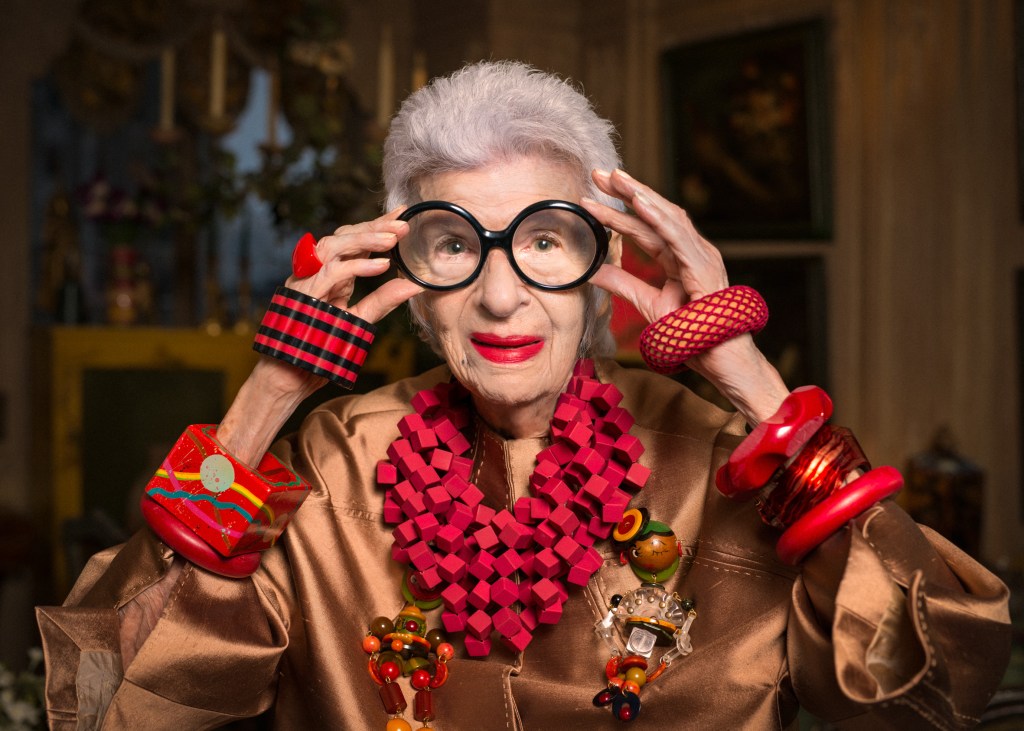“You made me the world’s oldest starlet.”
So said Iris Apfel after the rousing success of the Metropolitan Museum of Art’s Costume Institute exhibition devoted to her.
Former curator in charge of the Costume Institute and fashion scholar Harold Koda reminisced about her Saturday. “I wouldn’t call Iris’ pleasure in getting dressed a hobby, unless you think of Matisse as a hobbyist who cut out colored papers as a diversion. Dressing up for Iris was a vocation. She did have a hobby — it was shopping. Not you and me shopping, big-game hunter shopping. She might have looked like a bird-of-paradise, but on the hunt, she was a raptor.”
Provenance didn’t matter to Apfel, because she was such an independent thinker and creative. “It was purely based on visuals,” Koda said, recalling how she once paired a pink Lanvin jacket with all of this turquoise jewelry from the southwest, Tibet and other ports of call. “It wasn’t about matchy-match. It was about what goes together to make this the strongest statement. She was completely original in terms of that. Rules really didn’t apply to her.“
Apfel’s aesthetic principles were not articulated in a conventional way, and her purchases were not motivated by where something was from or whether it was expensive, said Koda, who orchestrated the Met’s 2005 show “Rara Avis: Selections from the Iris Apfel Collection,” at the Costume Institute. That helped further spark her popularity and made Apfel the first living person, who was not a designer, to have her clothing and accessories exhibited at the museum.
It was the contemporary fashion historian Caroline Milbank who had tipped off Koda to the fact that “the greatest collection of fashion accessories in this country, not fine jewelry — bags, costume jewelry, hats and gloves — belonged to this woman, who lived in New York.”
Without knowing Apfel’s identity due to Milbank’s discretion, Koda tucked away the information and later when another exhibition fell through, Koda liked the prospect of staging a show about accessories — not fine jewelry — at the Costume institute for the first time. During his first visit to Apfel’s apartment, it was difficult to determine its size, since boxes of the clothes that she had acquired over the years occupied the better part of the three bedrooms and the living room.
Part of what made Apfel’s collection so exceptional was the context in which it was shown — on her. “She collaged all these different patterns, colors, eras and cultures, and ended up with something quite lucid,” Koda said. “As a costume historian, I thought she was peculiarly American.”
At the opening at The Met, after Apfel showed a Tunisian bridal tunic that she had styled into a dressy, informal evening ensemble, he said, “In a thousand years, no Tunisian bride has been dressed as beautifully.”
Unlike Anna Piaggi’s or Isabella Blow’s “strong person’s style,” Koda said, “With Iris, as eccentric as she was due to the boldness and layered character of what she did, there was still a graphic principle. It never looked discordant.”
At a Connecticut antiques show, Apfel spied two mannequin hands that were “beautiful. But who needs two mannequin hands?” Koda said. “In another barn, she found a rosary for a santo, one of those religious figures, with beads the size of gumballs that were made in the same tone of wood as the hands that she has just bought. In the show, she used them with the mannequin hands grasping each other. She bought things that interested her not to match them. It was a fortuitous thing that it all converges.”
At the time of the “Rara Avis” show, Koda advised, “’Don’t attempt this at home,’ because the rest of us might throw things together in what we think is an artful way but it would not read as graphically considered as Iris always did.”
Despite the exhibition rocketing Apfel’s into a new realm of endorsement and influencer deals, the exhibition was more about how the collection came together than the individual designers that comprised it. “The fact that the collector was an artist, who took all of these things that were in her fashion palette meant that she was ending up herself as self-created art,” Koda said. While he made all of his selection adhering to The Met’s criteria for museum-worthy material, he asked Apfel to style the mannequins to make the story her own.
Many would be mistaken to think that great women of style are “narcissistic, vain or like bobblehead dolls,” the ones that are identified with bringing something really original to fashion are all really smart, according to Koda. The consummate dinner companion, who engaged in extraordinary conversations, Apfel “kept the stories coming.” Her many travels always involved meeting people and enriching her wide circle of friends. Her tales included the time a Times Square pimp offered her husband Carl cash for his Ferrari, while Iris was visiting Duke Ellington in a recording studio, Koda said. And the one when she got an Irish antiques dealer to sell her a Ptolemaic ring that once belonged to King Farouk even though it was reserved by the mayor of Dublin for the Grand Rebbe of Jeruselum’s upcoming visit.
Even in her 90s, she was made for social media, not only because of her exceptional persona, but also because her gimlet world view was an endless source of epigrammatic pronouncements. She was, an Oscar Wilde with googly glasses. And despite her age, she had the uncanny ability to connect with the young, especially teens. To the questioning adolescent, her message of “‘Be bold, express yourself, declare your originality’ resonated,” Koda said.
Apfel’s slimness and stature enabled her to carry off some adventurous silhouettes and choices, like her standard practice of wearing a raincoat as a dress on occasion — as another American style arbiter, C.Z. Guest, loved to do, Koda said.
Even weekend visits in the country couldn’t stop Apfel from shopping. During a jaunt to see Koda in upstate New York in the early 2000s, “he made the mistake” of going with her to the Stormville Flea Market instead of dropping her off. By that point, the market was mainly cheap jeans from Sri Lanka and Home Depot-style plants. “You didn’t find the contents of the attic of a house on the Hudson. I tried to discourage her. For her, being in the country was nothing — it was about shopping.”
What was expected to be a one-hour outing turned into three hours. Three stalls into a flea market with hundreds of stalls, she unearthed knockoff Kate Spade mini shoulder bags in all of these striped patterns and colors, and bartered with the vendor to sell them for $3 for the six. “She was such a haggler. I found it upsetting. But that’s just who she was whether high-end or low-end, she just bargained you like an 18th-century rug merchant,” Koda said. “By the time we brought her back to New York City, you couldn’t use the rear-view mirror in our station wagon.”



